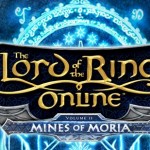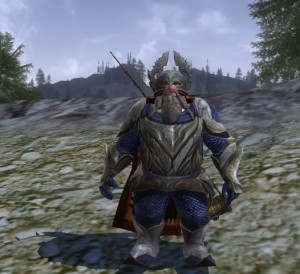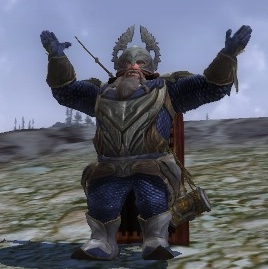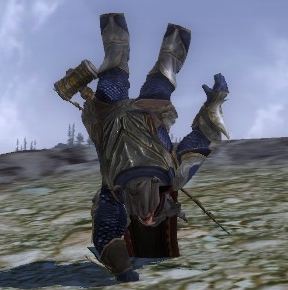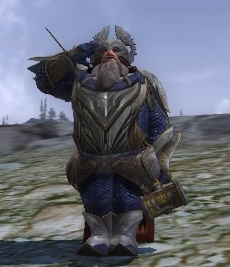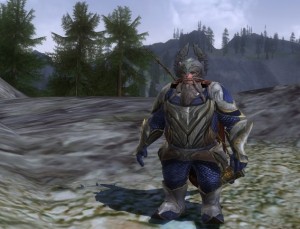Well, technically I spent the weekend in the surrounding parts of Eregion, but I certainly did step into Moria eventually. The first full expansion of the Lord of the Rings Online has been released – The Mines of Moria. I was pretty excited, I’ve always loved Tolkien’s dwarves and the body of lore they spawned in fantasy games like D&D, Warhammer, etc. I tend to end up playing dwarves in many of the fantasy games I play, and the character I spend most time on in Lord of the Rings Online (LOTRO) is a dwarf (guardian).
There’s something about the Mines of Moria that fills me with wonder and excitement both in Tolkien’s writing and in the movies. It’s no surprise therefore that I was looking forward to this expansion for the content alone.
Since the initial release there has been a massive amount of free content released for LOTRO including entire new areas, hundreds of new quests, thousands of new items, recipes, and lore. So you can bet any expansion you have to pay for is going to have to contain vast amounts of content to keep people happy. Moria’s content covers a cross-over area Eregion (in Eriador), which leads into Moria and finally into Lothlórien (both in Rhovanion). Eregion is a single ‘map’ location with four or five main quest areas. Moria is a bunch of different map locations, each of which looks pretty big and enjoyably complex, although I’ve so far only seen the first area. I’ve not been to Lothlórien so can’t comment on how large it is.
Each of these areas clearly have a huge number of quests and the Epic quest line has been updated to include the fellowship activity in the new locations. For casual players like myself at least, questing is the core of LOTRO, with most equipment, cash and experience coming from quest rewards, so whether an area is any good depends a lot on the quests, how they feel and how much they connect you to the Lord of the Rings lore.
As well as the new content, the expansion brings an increase to the level cap of 10 levels (maximum level is now 60), two new classes (Rune-Master and Warden), new skills, deeds and traits appropriate to the new levels and Legendary items. A new rank of tradeskill proficiency has been added (supreme) and new tradeskill resources and recipes required for that, additionally tradeskill guilds have been introduced which provide another source of recipes and require the gathering of guild reputation.
So, there’s a fair amount of stuff, and since both myself and Grete were still feeling pretty under the weather on Saturday, we decided to stay in and ‘play a little LOTRO’, which translated to spending most of Saturday and Sunday trying out the new content. Here, in no particular order, are my general thoughts.
Fixes
The best ‘fix’ in the patch for Moria is that quest items no longer take up inventory space, they go into a special ‘slot’ against the quest. This is really good news, as I said earlier the core activity in LOTRO is questing, and that results in bags half full of half completed quest items. You can have around 40 active quests and if they all require you to gather some things it can soon get hard to manage. The new system frees up a lot of inventory space which is tightly managed in LOTRO and makes questing less painful.
Classes
I briefly played with a Rune-Master, levelling a character to 8. I’m always impressed with the classes in LOTRO, given there are two main archetypes (caster and melee) I’m always amazed that each melee or caster class has something unique to differentiate it from the others. No two melee play the same, and no two casters play the same. Rune-Masters use combat or healing skills, and the use of those skills builds combat or healing counters which either improve or prevent other skills in the fight. For example, in order to use some powerful combat ability you have to amass combat counters by using lesser combat abilities, but some healing abilities decrease combat counters and increase healing counters. Some healing abilities can’t be used if you have any combat counters and vice versa for some combat skills. The net result of this apparently complex but actually simple system is that during any single encounter the Rune-Master has to specialise in damage or healing and probably won’t be easily able to switch mid-fight. This unique slant made for some interesting choices even at low levels, and I can imagine the scope at higher levels is even greater.
I haven’t played with a Warden, but the combat mechanic appears to allow you to build special attacks by combining earlier attacks. Unlike previous classes which have defined routes to certain special abilities based on their skills, this appears to allow a more flexible approach to building a wider range of special abilities. Grete seemed to enjoy it at low levels.
Eregion
This location is the introduction to the new expansion and is entered via the Trollshaws. With the exception of some fellowship quests in an instance full of elite creatures, I’ve pretty much done every obvious quest, and it was really enjoyable. The area is split into four main quest hubs, each progressing in difficulty and all having horse masters. A progressive deed allows you to obtain swift travel between the hubs, with initial travel being slow and having to be opened by visiting the horse master at least once (standard LOTRO approach).
The area is pretty open, with a number of ruins, some mountains and dry water-bed features and is mostly green (grassland, trees). In the south-eastern part of the area is a location which leads to another small map which contains the entrance to Moria and has the Black Pool. I like the open nature of LOTRO areas, they don’t usually restrict your movement by anything other than increasingly difficult creatures to get past, and Eregion is no different. The one exception is that it’s not possible to gain access to Moria until you complete the introductory quests in the Epic line (carried out in the little area mentioned above).
The general quests in Eregion cover the whole range of normal quest activity in LOTRO, and other than being made more difficult by the huge number of people present in the zone were fun to do.
The access quest line for Moria is fun and designed to be done solo (in fact, two stages have to be completed solo). They take place in a special version of the Black Pool area with a whole range of quest NPC’s and mini-quest dungeons. Once you get past a certain stage in this quest line you can no longer get into the special instance area, even if you’re in a fellowship with someone doing those quests. This is a bit of an issue (especially when we didn’t realise it would happen) because you can’t help your friends out. However, the access quest is soloable and not too difficult, it’s the other unrelated quests in that area that are tougher and have some decent rewards that might be more troublesome when 200 people aren’t doing it at once.
Once you fully complete the quest, you gain access to Moria through a more general Black Pool area which I’ve not fully explored yet to see if the instances still exist as well.
The access quest is very atmospheric and without giving away too many spoilers you get to see some tentacled and flaming creatures of legend.
The rest of Eregion is populated with the usual range of LOTRO creatures, wolves, wargs, beasts, humans of varying evilness and origin, a new lizard model, crows and trolls. My Minstrel progressed from level 48 to near 51 by completing most of the Eregion quests.
There are several key locations in Eregion that tie in with the Fellowship in the book, and they evoke enjoyable memories and make you feel close to the lore.
Moria
I’ve spent very little time in Moria so far, but wanted to give my initial impressions. Wow. Epic, huge, grand, amazing. The entrance hall is epic and the subsequent locations are brilliantly visualised. You get a real sense of the enormous scale of the place and the music is simply breathtaking. If the questing and adventuring lives up to the visuals it will be fantastic. We got totally lost three or four times trying to get from the entrance to the second secured location, and enjoyed every wrong turn.
Travel within the mines is achieved either on foot, or by goat ride between major locations once discovered.
Legendary Items
The biggest equipment change in the new expansion is the introduction of Legendary items. Essentially, they are items which can be customised through the addition of relics, improved in power through the earning of experience and further customised by spending that experience on increasing special skill-based features on the items (like skill cost reduction, increase duration, increase damage, etc.) The reward for the Moria access quest is a Legendary item and the quest involves learning how to improve it which is a good introduction. Items gain experience through normal kills and through some quests, as well as via experience boosting dropped items. The experience does not detract from the regular character earned experience, but if you have more than one item currently levelling they do split item experienced earned.
I won’t cover these in too much detail, suffice to say that they bring a big amount of customisation that some people will love and others will gloss over mostly, and increase the complexity and scope of high level characters. I don’t know if lower level Legendary items will be added, although I suspect not from the lore given when you get your first one. You’ll either love them or just cope with them, but you won’t be able to avoid them.
Tradeskill Changes
I have mixed feelings about this, because an early bug meant that my Dwarf Guardian had some of his earned tradeskill points removed and I had to spend 3 hours making things to get them back. A new rank of tradeskill has been added (Supreme), which adds a new level of recipes and a whole new bunch of resources. The resources seemed plentiful in Eregion, although there appear to be two or three ranks of new resources (this is different to previous skill levels), with the higher rank resources showing up further inside Moria and beyond only. I do tradeskill more from an obligation to be at the highest rank, and because it gives some nice toys, rather than because I truly enjoy it, so I’m not the best person to review this addition.
I do like the introduction of tradeskill guilds, of which you can only be a member of one. Each guild provides new recipes (mostly more efficient versions of existing recipes, or slightly better versions of the results) which have long cooldown timers. They also introduction a range of guild token item recipes which are used either in the aforementioned new recipes or in gaining reputation with the guild, which is in turn required to buy further recipes. The interesting angle here for me is that it provides a reason to go back and collect low level resources to make guild tokens and gain reputation. Other people will consider it simply a straight time sink.
Conclusions
I’m biased. I’ve loved the Lord of the Rings since I read the books. I loved the movies. I love the lore, the concept, the very idea of being within Middle Earth taking on Goblins and Orcs. The Mines of Moria held special importance for me because I enjoy roleplaying dwarves, and the ideas of lost kingdoms, heroics and forgotten wealth inspire me. There was never any doubt I’d buy this expansion. With all that said, it had a lot to live up to, and so far it’s managed it quite handily. Eregion was fun and challenging and the Moria access quest was interesting. My first view of Moria was suitably awe inspiring, and subsequent exploration suggests there’s more to come. The bug with tradeskills pissed me off at first, and I’m just about over it. But it can’t quell the enjoyment I get from bashing orcs over the head and shouting Baruk Khazâd! Khazâd ai-mênu! with the iconic images of Moria all around me and the sound of drums in the deep.

